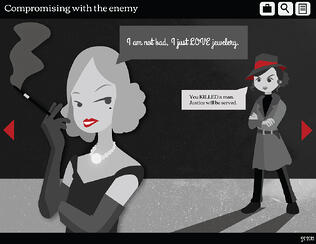Blog
5 Tricks to Demolish your Creative Blocks
By Hannah Hunter, Instructional Writer I love designing elearning courses for teens and young adults. I get to be creative and young learners are the ...


Generational Learning Design: 3 Ways to Overcome the Need to be "Cool"
By Hannah Hunter | June 25, 2015 | Custom Learning | 0 Comments
By Hannah Hunter, Instructional Writer

I love designing elearning courses for teens and young adults. I get to be creative and young learners are the perfect audience for e-learning because...
-
They are incredibly technically savvy
-
They love video games, humor, and individualized experiences—all things e-learning can offer
-
The teen brain has amazing potential—IQ points can rise or fall 20 points during this sensitive time
-
They are always on their phones, making quick, mobile learning events easy to integrate into their world.
Yet, despite their amazing potential for curiosity and discovery, generational learning design for the younger demographic can be incredibly challenging. Not because there is anything “wrong” with teenagers, but because we as instructional designers don’t understand what motivates this group of learners the same way we understand what motivates adults or younger children. So, in doubt, we resort to a word that has become one of my biggest pet peeves in e-learning: We try to make it “cool.” Here are some reasons why you should erase “cool” from your vocabulary and some tips on what to do instead.
Problem: Cool is a lie
“Cool” is a completely subjective concept—like “good” or “interesting.” Ask a thousand people what it means and you’ll get a thousand different answers. When we talk about designing e-learning for teens, our definition of cool is usually “that which appeals to people ages 13 to 21.” The truth is, teens and young adults are a very diverse group of people with different interests, maturity levels, backgrounds and tastes. There is no one thing that appeals to all members of that age group.
1. Solution: Learn about your audience

Take the nebulous concept of “appealing to youth” and break it down. Determine the type of youth you want to appeal to—and don’t say “all of them.” A teen audience is, after all, just as diverse as an adult one—if not more so. Get inside the shoes of your ideal learner and figure out what makes them tick. What inspires them? Who is their favorite teacher and why? What was the last thing that made them laugh really hard? Preferably, you will do this by actually talking to a few teenagers. After all, the true Subject Matter Experts (SMEs) of “things that appeal to youth” are actual youths. Having a strong understanding of your audience is key to creating a course that will resonate, and as an added bonus, young learners love to be asked for advice!
Problem: Your content is not cool
“I want kids to think this learning course is so cool that they tell all their friends about it on Facebook!”
“What’s the elearning course about?”
“Substance Abuse!”
I polled some teenage girls and asked them what kinds of things are cool these days. I got answers like: pastel hair, books by John Green, galaxy print, and strong eyebrows. Weirdly, no one said “learning about alcoholism.”
Some topics are incredibly important—even interesting—but will never be cool no matter how sleek and modern your interface is. Trying to paint every project we make with the “cool” brush can diminish the seriousness of the content and feel patronizing to learners.
2. Solution: Consider the emotional context of your content
Context is SO important. We often talk about context in terms of media. However, context also includes the emotional context of the course—recognizing how a learner might feel about the topic being covered. Some content, like math, is fairly “neutral” in terms of emotional context and that gives you more freedom to create the mood you want. But, a lot of the e-learning directed at teens covers some pretty heavy subjects: bullying, mental and physical health, and substance abuse to name a few. Consider your target demographic, a teen who struggles with any of those issues. That person wants practical information, presented honestly and compassionately, in a tone that conveys the gravity of their life experience and gives them hope that things will get better. They don’t want to talk about it on Facebook.
Problem: Coolness is superficial
Making e-learning “cool” usually ends ups meaning that we spend a large chunk of the budget creating a sleek mobile-compatible interface and integrating social media. And that would be fine, except we don’t always put the same energy and care into developing the interactivity and messaging of our course that we do to making it pretty. We spend our money on the wrapping paper and forget to put anything in the box. Teens resent the fact that adults think they are superficial. Don’t prove them right!
3. Solution: Strive to be fascinating, inspiring, and genuine
When it comes to what teens enjoy in e-learning, their views do not differ much from an adult learner. They enjoy playing engaging games and solving puzzles. They like reading interesting and inspiring stories. They love humor and learning that doesn’t take too much of their time. They like learning, not because it’s cool or fun, but because it makes them feel like they are becoming more capable people.
Three of the most popular accounts on Twitter among teens and young adults are: Bill Nye (scientist), Neil Degrasse Tyson (scientist), and NASA (lots of scientists). These are not people who are particularly fashionable or edgy, but they are popular because they appeal to a teen’s natural curiosity and sense of justice with insight, wit, and passion without ever talking down to them or trying to be someone they aren’t.
Putting it together
My plea is this: erase cool from your vocabulary and replace it with something actionable. Learn about your audience by talking to them, not by Googling “what are kids into these days.” Be humorous, be insightful, and be fascinating. Of course, you can also design your interface to be fresh and modern. Use social media in your e-learning. But, do those things because they enhance your overall course, not simply because they are on the a-la carte menu of “cool things” and you wanted to squeeze some Facebook in there somewhere. Most of all, be true to your own strengths as an instructional designer and to the strengths of your content.
WANT TO SHARE THIS BLOG? CLICK THIS READY-MADE TWEET BELOW!
CLICK TO TWEET: #aiblog: #Generational #Learning #Design: 3 Ways to Overcome the Need to be "Cool" http://hubs.ly/y0X6b10 @customelearning

About the Author: Hannah Hunter
Hannah Hunter is an instructional writer at Allen Interactions. When she’s not sharing her passion for life-long learning, Hannah enjoys painting, experimenting with new recipes, and volunteering as a creative writing tutor for middle and high school students. She also frequently blogs on Allen Interactions’ e-Learning Leadership Blog.
Comments
Would you like to leave a comment?
Related Blog Posts

By: Hannah Hunter | Mar, 2015
Category: Custom Learning

Blog
What’s Your Training Worth? Demonstrate ROI by Tracking KPIs
By Hannah Hunter, Instructional Writer I love designing elearning courses for teens and young adults. I get to be creative and young learners are the ...
By: Hannah Hunter | Mar, 2017
Category: Custom Learning, Strategic Consulting

Blog
4 Tips to Maximize Your e-Learning Graphic Designers' Time
By Hannah Hunter, Instructional Writer I love designing elearning courses for teens and young adults. I get to be creative and young learners are the ...
By: Hannah Hunter | Jan, 2015
Category: Custom Learning


